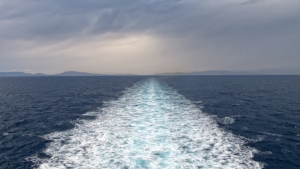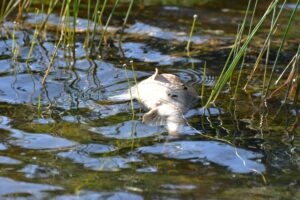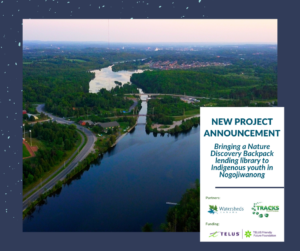New community partnerships in 2025 provide 2,000 children and youth with hands-on environmental learning and exploration opportunities. Watersheds Canada expanded its Nature Discovery Backpack program in 2025, launching 7 new lending libraries in collaboration with community partners in Manitoba and Ontario. Over 60 new curriculum-linked backpacks were created which will provide families, children, youth, and community groups with free access to hands-on environmental learning tools that ... Read More
10 Days of Winter Activities for the Whole Family!
by Amy DeBoer, Riparian Habitat Restoration Intern Canadian winters can be cold and dark, but that just means we get to be more creative in how we enjoy the outdoors! Here is a list of 10 activities to inspire you and your family to enjoy all the winter season has to offer. 1. Decorate the Windows A Canadian winter tends to be less colourful than our other seasons, so why not add some ourselves! Using washable paint or markers, you can create temporary window designs. This craft can ... Read More
Can you discharge your boat’s greywater to lakes and rivers?
by Andres Clavier, Freshwater Stewardship Education Intern Canada's commitment to preserving its pristine water bodies is reflected in its regulatory framework. The primary legislation governing boat discharge is the Vessel Pollution and Dangerous Chemicals Act. This law covers pollutants ranging from oil and chemicals to sewage from marine vessels. Under this Act, all vessels with installed toilet facilities are required to have a marine sanitation device on board. This device is intended to ... Read More
Watersheds Canada Launches Free Online Resource Library
Watersheds Canada is excited to announce the launch of a new online resource library – a free, one-stop shop designed to make freshwater conservation information accessible to everyone. From waterfront property owners and municipal staff, to community associations, educators, families, and researchers, this digital library offers practical tools and resources across a wide array of topics to protect and restore Canada’s lakes, rivers, and shorelines. The online resource library brings ... Read More
Watersheds Canada announces its new Board Chair
Watersheds Canada is pleased to announce the appointment of Mike Thomas as the new Chair of its Board of Directors. This leadership transition marks an exciting milestone as the 24-year-old national charity continues to advance its mission of restoring freshwater environments and engaging communities from coast to coast to coast. Mike Thomas discovered the work of Watersheds Canada from his own cottage dock in Haliburton County, Ontario. Through his ongoing volunteer commitment to his local ... Read More
The Effects of Septic Pollution on Biodiversity
by Paige Jessup, Climate Change Resiliency Intern The loss of biodiversity in freshwater and terrestrial ecosystems has been a growing issue for freshwater communities. Run-off from improperly installed or unmaintained septic systems are one of the ways that untreated wastewater gets into freshwater bodies. Things like cracks in the tank can also cause nutrients from the wastewater to leach into the soil, which can lead to highly undesirable changes in local ecosystem structure and ... Read More
Watersheds Canada receives $10,000 Community Board grant from the TELUS Friendly Future Foundation, supporting a Nature Discovery Backpack lending library for Indigenous youth in Nogojiwanong
Funding will help to provide 200 Indigenous youth with a free immersive nature learning program while using community monitoring technology to steward local habitats Perth, Ontario, December 11, 2025 – Watersheds Canada has received a $10,000 Community Board grant from the TELUS Friendly Future Foundation®, through the TELUS Barrie and Central Ontario Community Board, supporting increased access to locally-informed and relevant freshwater education and action opportunities for ... Read More
Hidden Dangers: How Could your Septic System be Affecting Water Quality
by Paige Jessup, Climate Change Resiliency Intern Our septic systems are often something that are out of sight and out of mind. Some people may not even know what a septic system is, especially if you live in a city or town that has a wastewater treatment plant. No matter where you live, we should all be thinking about where our wastewater goes when we flush. Where is Untreated Wastewater Going? If you live in an area that is connected to a municipal sewer system, the water that is ... Read More
And the winners are…
Watersheds Canada's inaugural Nature Art Raffle was a tremendous success! The winning ticket numbers were drawn on Friday, November 28, 2025 at 11:00am EST and here are the winners: Chris S. from Georgetown, Ontario has won the Sue Miller oil painting. Erik P. from Cassleman, Ontario has won the Mike Reader wood duck carving. Erik's impact on freshwater doesn't end here - we are thankful to announce that he has signed on to be a monthly donor to Watersheds Canada. His generous support will ... Read More
Watersheds Canada wraps up another successful year of delivering Love Your Lake
November 21, 2025 -- Watersheds Canada is celebrating the successful completion of another year delivering the Love Your Lake program, now in its thirteenth year of operation. In summer 2025, the team worked in Central-Eastern Ontario, assessing over 1,100 properties across five lakes: Sand Lake, Black Lake, North Otter Lake, South Otter Lake, and Eagle Lake. This important work was made possible thanks to support from local volunteers, hosts, lake associations, and community members. Through ... Read More
- 1
- 2
- 3
- …
- 21
- Next Page »










